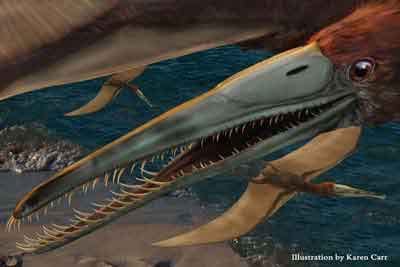National Geographic News interviewed SMU postdoctoral researcher Timothy S. Myers about the new species and genus of pterosaur he identified and named, Aetodactylus Halli.
In the April 28 article “Toothy Texas Pterosaur Found; Soared Over Dallas” reporter John Roach talked to Myers about the 95 million-year-old jaw that was discovered by Lake Worth resident Lance Hall.
The pterosaur flew over the ancient sea that used to cover much of the Dallas-Fort Worth area. A rare species of pterosaur in North America, Myers named the new flying reptile after Hall.
Others who wrote about Myers’ Aetodactylus Halli research include:
- The Christian Science Monitor with “Aetodactylus halli fossil: a clue in North American mystery”
- CBS 11 with “Texas Man Makes Fossil Find While Out Walking”
- Fort Worth Star-Telegram with “New Honor For Ancient Find”
- Dallas Observer with “95 Million Reasons Why Unfair Park Needs More Dallas Dinosaur News”
- Discovery News with “Texas Has A New Toothy Pterosaur.”
Others who published a story about the find were: American Scientist, MSNBC, FOX News, the San Diego Tribune and many others.
EXCERPT:
By John Roach
National Geographic News
Long before six flags flew over Texas, a newfound species of winged reptile
with an exceptionally toothy grin owned the skies over what is now the Lone
Star State.The recently discovered pterosaur, dubbed Aetodactylus halli, was identified based on a 95-million-year-old lower jawbone found outside of Dallas by amateur fossil hunter Lance Hall.
The pterosaur had a relatively slender jaw filled with thin, needlelike teeth, which might have helped the creature pluck fish from the shallow sea that once covered the region, a new study says.
“It was hanging out near the ocean, and that is probably where it derived its food from,” said study leader Timothy Myers, a paleontologist at Southern Methodist University in Dallas.
By comparing the jawbone to more complete pterosaur fossils, Myers and his team think A. halli was a medium-size animal with a nine-foot (three-meter) wingspan and a short tail.
Texas’s Toothy Pterosaur a Rare Find
Pterosaurs ruled the skies from the late Triassic period, more than 200 million years ago, until dinosaurs went extinct at the end of the Cretaceous, about 65 million years ago.
 National Geographic News interviewed SMU postdoctoral researcher
National Geographic News interviewed SMU postdoctoral researcher  By artist Karen Carr / See
By artist Karen Carr / See 